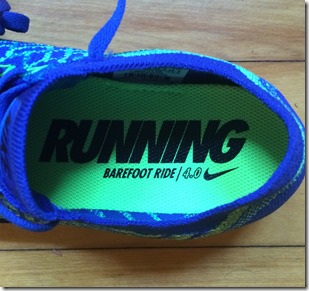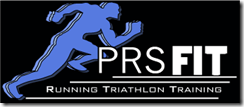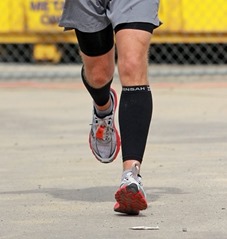 Nike has long touted the design of their Free line of running shoes as having been inspired by barefoot running. Indeed, the newest Free shoes have the phrase “Barefoot Ride” written right on the insole (see photo at left). Personally, I’m a fan of the Frees since they suit my preference for light, flexible, moderately cushioned shoes. However, despite their more minimal structure, I don’t think they really come even close to simulating the experience of running barefoot (few shoes do).
Nike has long touted the design of their Free line of running shoes as having been inspired by barefoot running. Indeed, the newest Free shoes have the phrase “Barefoot Ride” written right on the insole (see photo at left). Personally, I’m a fan of the Frees since they suit my preference for light, flexible, moderately cushioned shoes. However, despite their more minimal structure, I don’t think they really come even close to simulating the experience of running barefoot (few shoes do).
In my recent review of the Nike Free 5.0 I cited a study that compared running biomechanics in the Nike Pegasus and the Nike Free 3.0. This research has been out for awhile, but I never wrote about the paper. Since I’ve been running a bunch in various Nike Free shoes lately, I thought I’d write up a summary.
The study is authored by Richard Willy and Irene Davis and is titled “Kinematic and kinetic comparison of running in standard and minimalist shoes.” It was published in 2014 in the Journal Medicine & Science in Sport & Exercise. Here is the Abstract:
Abstract
PURPOSE: The purpose of this study was to determine whether running in a minimalist shoe results in a reduction in ground reaction forces and alters kinematics over standard shoe running. The secondary purpose of this study was to determine whether within-session accommodation to a novel minimalist shoe occurs.
METHODS: Subjects were 14 male, rearfoot striking runners who had never run in a minimalist shoe. Subjects were tested while running 3.35 m·s(-1) for 10 min on an instrumented treadmill in a minimalist and a standard shoe as three-dimensional lower extremity kinematics and kinetics were evaluated. Data were collected at minute 1 and then again after 10 min of running in both shoe conditions to evaluate accommodation to the shoe conditions.
RESULTS: Shoe-time interactions were not found for any of the variables of interest. Minimalist shoe running resulted in no changes in step length (P = 0.967) or in step rate (P = 0.230). At footstrike, greater knee flexion (P = 0.001) and greater dorsiflexion angle (P = 0.025) were noted in the minimalist shoe. Vertical impact peak (P = 0.017) and average vertical loading rate (P < 0.000) were greater during minimalist shoe running. There were main effects of time as dorsiflexion angle decreased (P = 0.035), foot inclination at footstrike decreased (P = 0.048), and knee flexion at footstrike increased (P = 0.002), yet the vertical impact peak (P = 0.002) and average vertical loading rate (P < 0.000) increased.
CONCLUSIONS: Running in a minimalist shoe appears to, at least in the short term, increase loading of the lower extremity over standard shoe running. The accommodation period resulted in less favorable landing mechanics in both shoes. These findings bring into question whether minimal shoes will provide enough feedback to induce an alteration that is similar to barefoot running.
Rationale and Methods
Many runners choose a moderately cushioned shoe to transition toward more minimal footwear figuring that it is a safer approach than jumping right into a shoe with no cushion at all. Because of this, the authors were interested in determining if running in a cushioned “minimalist” shoe might more closely simulate barefoot-like running mechanics than a more traditionally cushioned shoe. To address this, they recruited 14 heel-striking runners and had them run in both the Nike Pegasus and the Nike Free 3.0. The Pegasus has about 20mm more cushion in the heel, and the cushioning in the Peg is also significantly softer than that of the Free. Each runner ran two 10-minute trials on an instrumented treadmill, one in each shoe, and biomechanical measures were recorded near the beginning and end of the trials to see if acclimation time to the shoes had any effect.
Results
Contrary to expectations, step rate (both shoes just under 170 steps/min), step length, and foot inclination at foot strike did not differ between the two shoes. Even more unexpected was the fact that ankle dorsiflexion, vertical impact peak, and vertical loading rate were all significantly higher in the Nike Free 3.0.
Comparisons from the beginning to the end of the 10 minute run did not reveal any acclimation differences between the two shoes. In both the Pegasus and the Free 3.0 runners did not alter step length or rate, foot inclination and ankle dorsiflexion decreased, knee flexion at foot strike increased, and vertical impact peak and loading rate increased over the course of the run.
Commentary
Contrary to expectations, runners in the Nike Free 3.0 exhibited higher impact and loading rates compared to when they wore the Nike Pegasus. Furthermore, they did not exhibit changes typical of barefoot runners such as reduced step rate and stride length, or reduced foot inclination at initial contact that is indicative of adopting a midfoot or forefoot strike. In plain terms, the Nike Free 3.0 didn’t do a good job of simulating barefoot running. Rather, wearing the barefoot-inspired shoe resulted in a more impactful stride.
So what might be going on here? The authors suggest that “In order to see a change in footstrike pattern that simulates barefoot running, the shoes may need to be as minimal as possible.” In other words, the Nike Free 3.0 has enough cushion that it does not encourage alteration of the running stride in the direction of barefoot running. However, it has less cushioning than a traditional shoe and is firmer than the Pegasus so continuing to heel strike in a shoe like this results in increased impact loading. I should point out that I have observed that almost 50% of runners in the minimally cushioned Vibram Fivefingers continue to heel strike, so it may be that no shoe really does a perfect job of encouraging a barefoot-like stride.
The authors further point out that loading rates in the Free 3.0 exceeded those reported for runners with a history of tibial stress fractures. Other research has found that transitioning into Nike Frees increases injury risk to a greater degree than transitioning into the Nike Pegasus or the Vibram Fivefingers (injury risk in the latter two did not differ). We don’t know for sure if increases in impact loading might explain the increased injury risk in Frees (it could be their extreme flexibility or some other factor), but the combined results of these studies suggest that caution is warranted when beginning to run in a flexible, moderately cushioned shoe like the Nike Free 3.0. At the very least, runners should pay attention to running form when transitioning into a moderately cushioned shoe as they will not provide the same level of protection for a runner with a high-impact stride.



















When I first started running I was sold on motion control all the way. A few years ago I started playing with a much wider variety of shoes from vibrams to Hokas. I have found as long as I mix up my shoe types weekly my injury rate has decreased [providing the feel is good in the shoe]. My theory is that running in the same type of shoe stimulates the same muscles, and thus can create weakness in some areas. Plus the best benefit of this approach is having a large shoe collection. Mixing up running surfaces is equally helpful.
I agree completely, a rotation is the way to go.
Great advice here, congrats.
The impression of safeness is what scares me. If in a 10 mins controlled environment the Nike Free 3.0 induced a “more impactful stride”, I wonder what happens in real training when you’re tired.
The problem is that the test was too short. I think transitioning needs more time and it is not achieved in the first run with a new shoe. In my case I use the Free even for marathons and I have certainly changed my stride from heel to midsole, however it happens some years ago and It was not a fast process.
correction, “it happened”.
This hints at supporting my own anecdotal “n of 1” experience: but even “barefoot” five fingers type shoes do not change my mechanics as much as true barefoot running. Also, my ancient achilles tendonopathy is exacerbated by too much running in either conventional, inflexible shoes like the Pegasus or 4mm drop soft shoes such as the Kinvara. I now do most of my running in 8-10mm drop marathon racing shoes with preference to firmer midsoles, which give me more proprioceptive feedback, such as the Adidas adios or NB 1400 series, or else run barefoot on grass, which prevents both overstriding and (counterintuitively) excessive pronation in my case.
I do wonder though, why test subjects would heel strike in the Frees as much as they would in the Pegasus. Surely there is a continuum of how the foot would land, from Clydesdale shoes through the Pegasus down to the Frees?
I mean, a continuum, even for those designated as “heel strikers”. Even though I’ve been training in spikes on the track for 30 years, and am a midfoot striker, I still find that conventionally height stacked shoes of 12-14 mm almost force me into heel striking
That was the interesting thing about the study, it appeared the heel strike was even more prominent in the Free. Not sure why this would be the case.
Alas the last. Does the last, or shape of the shoe, have anything to do with biomechanics? It looks like the Pegasus models have a semi-curved shape while the Frees are curved.
I find I run long distances with minimal knee pain and muscle fatigue in a shoe with a straight or semi-straight shape, like the Pearl Izumi Tri N2. Shoes I’ve tried with a curved shape, like the New Balance 1400 v2, were disasters for me over distances more than 10K. I realize the NB 1400 is a lot lighter than the Tri N2, but does the shape of the sole affect a runner’s biomechanics at all? And what’s the difference between a semi-curved shape and semi-straight anyway?
Good question, and honestly I’m not sure of the answer. My guess is any factor like this could have an effect, and that’s an issue in comparing shoes, we don’t really know which difference might be responsible for changing biomechanics. Could be cushioning, flexibility, lack of a supportive upper, last shape, etc.
For me an 8 mm drop hits the sweet spot. I have found that a 4mm drop ends up killing my calves and making my stride more unnatural for how I run and how my foot strikes the ground-heel towards the mid foot. A too flexible shoe tends to do bad things to me too. I think I will try the Saucony Break Thru in my quest for the perfect shoe. :) I think we all have to find what works for each of us, as Pete has said before. We are all made different and have different needs. I am glad there is a wide variety of shoes available now-all thanks to the barefoot and minimal craze a few years back. Love your blog Pete!
Thanks Steve!
Good comments on this so far. As someone who has benefited from running in the Nike Free under test here, I have some comments of my own. The study does not really demonstrate a realistic scenario and instead demonstrates how to win a straw man argument. Some long time heel-striking, over-striding runner is hardly likely to change his gait by simply strapping on a pair of Nike Frees and going for a 10 minute jog on a treadmill. Changing running form requires instruction and practice, neither of which seem present here. A more meaningful study would include instruction about running form and much more running time in the shoes in question as part of training. It’d then be interesting to see what changes, if any, occur with both the Free and the Pegasus.
I think the Frees are emulating barefoot running on grass rather than on a hard surface. That was the inspiration behind the development of the Free in the first place where a Stanford track coach had his runners doing barefoot sessions on nice soft turf. Otherwise, why bother with any cushioning at all?